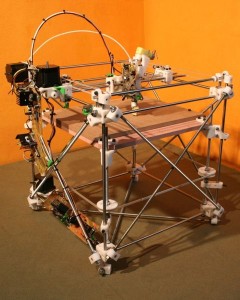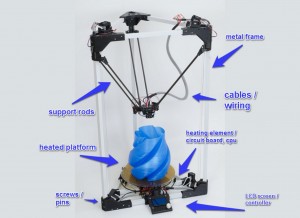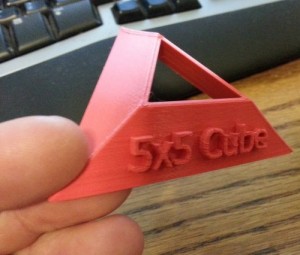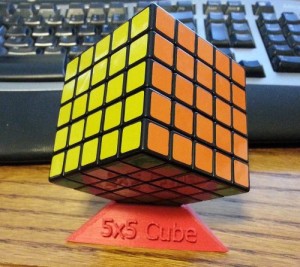Not too many months ago I ran across Richard Dawkins’ statement that life got its start when, somehow, on the early Earth a self-replicating molecule formed. I nearly fell out of my chair laughing. I had read the quote before, and he has repeated the idea in various writings and interviews, but after having studied the issues with abiogenesis in a bit more detail, in particular the concept of a self-replicating molecule to kick off the origin of life, the idea struck me as particularly preposterous.
In this post, I want to follow up on the other recent thread regarding abiogenesis. This time, however, I want to focus on the matter of self-replication.
The Abiogenesis Paradigm
As mentioned, the idea of a self-replicating molecule is central to most abiogenesis storylines. Dawkins is not unique in this view, but I offer one of his quotes so that the reader can understand the general thrust. In a 2012 COSMOS interview, Dawkins said:
Heather Catchpole: Have you put any thought into the beginning of life and into what kicked that off?
Dawkins: Not personally. I mean, it’s increasingly clear that the big step that had to be taken – and it was probably a step that involved a large element of luck – was the origin of the first accurately self-replicating molecule. Colloquially, you could say the first gene. Which probably was not DNA, it might have been RNA.
That’s the step that must have been taken in the origin of life, and that’s what people are working on all around the world. It’s hard to work on it because it happened a very long time ago under very different conditions, and it is a problem in chemistry rather than biology, it is pre-biology.
But the event in chemistry that must have taken place was the spontaneous arising of a self-replicating molecule. That’s how I stated it in The Selfish Gene and that hasn’t changed, but people are now actively working on various theories of how that might have happened. I’m not working on that.
Dawkins is of course not alone. The search for a self-replicating molecule is the Holy Grail of origin of life research. Indeed, you can take it to the bank that if a simple self-replicating molecule is ever discovered materialists will all but proclaim that the problem of life’s origin has been essentially solved.
The reason the elusive self-replicating molecule is so critical is that all honest researchers, even those committed to a materialist paradigm who dare not consider the possibility of design, acknowledge that there can be no evolution without a self-replicating entity.* Once a self-replicating entity appears on the scene, however, the magic of natural selection can take over and then . . . watch out! . . . anything is possible.
Not that there is any good evidence, mind you, that natural selection can produce the kinds of systems we see in living organisms, much less the coding, protocols, and information-rich aspects. But the vision of natural selection having near-mystical powers of creation has taken such hold on the evolutionary imagination that many individuals mistakenly believe with the magic wand of natural selection, “all things are possible.” Stated another way, it is not that there is good evidence a self-replicating molecule can give rise to complex life; it is just that once natural selection kicks in, the idea becomes more believable to many people.
But back to those first steps of life’s origin . . .
Most criticisms of abiogenesis have focused on specific evidentiary details: the reducing atmosphere, energy sources, the difficulty of forming polymers in the primordial soup, the existence of the necessary nucleotides or amino acids at the right place and time, homochiralty, interfering cross reactions, the rise of coding and information-rich molecules, and so on. Together these constitute a devastating indictment of the abiogenesis paradigm and give us ample reason to doubt the materialistic creation story.
However, much less time has been spent – and I want to focus on this today – on the issue of self-replication. Indeed, even many critics of abiogenesis have skirted the issue or seem to have implicitly bought into the idea that a self-replicating molecule may indeed arise early on in the process.
In short, under the abiogenesis paradigm, the process is as follows:
chemical reactions -> self-replicating molecule -> natural selection kicks in -> eons pass -> life as we know it
This approach puts self-replication at the beginning of the creative story, the opening curtain if you will, in the long and complicated drama that is the history of life on Earth. Under this paradigm, self-replication is viewed as the very first stage, the kicking-off point, the starting rung of the ladder of life. Rather than having a living organism and then endowing that organism with an additional ability of self-replication, the materialistic paradigm makes self-replication the first ability. Self-replication becomes the initial characteristic of an organism, the characteristic from which all others flow.
Let me say that again: Under the materialistic abiogenesis story, self-replication is the first characteristic of an organism to arise, the characteristic from which all additional characteristics then arise. Characteristics like homeostasis, the genetic code, molecular machines, control mechanisms, the ability to locate, process and utilize materials from the environment, and so on.
The First Step of Life
This view of self-replication as the starting point, the initiator, the first step toward all other biological characteristics is not only questionable, it is completely backwards. The abiogenesis story is upside-down. Unfortunately, a failure to think through what is actually required for self-replication, the engineering and programming realities, gives rise to muddled thinking. But for the magic wand of natural selection to kick in, self-replication must have been the first key step, the thinking goes. This is why Dawkins would say: “it’s increasingly clear that the big step that had to be taken . . . was the origin of the first accurately self-replicating molecule.”
This insistence on a materialistic origin of life, coupled with the hypnotic trance of the limitless power of natural selection, thus leads the materialist to draw a conclusion that is not only unsupported, but that is diametrically opposed to the physical, chemical and engineering realities we see in the world around us.
The Realities of Self-Replication
A number of researchers have considered what might be involved in getting a self-replicating organism. I have developed a tentative list of my own, but rather than lengthening this already too-lengthy essay, I will instead refer readers to the thought-provoking materials provided by InVivoVeritas.
In order to help us understand what is involved in self-replication, let us step back for a moment from the dizzying complexity of the living cell and consider what would be involved in building the simplest self-replicating machine possible with our existing technological understanding.
Self-replication has been the topic of much discussion in science fiction literature and movies, ranging from the large and powerful Terminator-style robots to small but deadly nanites. However, in actual practice, creating a self-replicating machine is not so simple.
Some might be tempted to point to a software program that can copy itself, but such programs are not self-replicating in any substantive sense. The software program only exists and runs on a carefully-designed and functional piece of hardware that is certainly not replicated in the process. Furthermore, there is generally an operating system, as well as several additional pieces of software in the form of drivers, compilers, interfaces, middleware programs, and so on. The most that can be said for such “self-replicating” programs is that a carefully-designed combination of hardware and software can produce a copy of a portion of the software.
No, true self-replication is a more onerous task. Once we consider the task of actually instantiating a self-replicating machine in physical, three-dimensional space, the challenges become a bit more obvious.
Let’s take a real-world example of attempts to create a self-replicating machine. To help us get a concrete idea of what is involved let’s look at the relatively-simple consumer-level 3D printers.
3D Printing
A considerable amount of effort has been dedicated toward the goal of self-replication and some modest gains have been made. One of the most exciting technologies to emerge in recent years is 3D printing. The ability of a machine to create various parts in three-dimensional space has set us on the path to the first realistic opportunity in human history to create a self-replicating machine.
I became interested in 3D printing years ago and have followed the development of the industry off and on ever since. Recently the technology has become cheap enough that 3D printers have moved, if not into the world of the everyday consumer, then certainly into the world of the hobbyist and the technology enthusiast. Popular consumer-level makers include MakerBot, FlashForge, 3DSystems, and others.
Today 3D printers range from personal machines costing a few hundred dollars that do rough prints in a single material to high-end professional printers costing many thousands of dollars boasting tolerances of less than one-tenth of a millimeter and printing in multiple materials. Numerous 3D technologies also exist, from material extrusion (the most common technology for consumer and prosumer printers), light photopolymerization, powder bed fusion, ultrasonic additive, laser-induced, electron beam melting, and more.
Despite my interest in this area, I have not yet taken the plunge to buy my own printer. I am guessing that within the next 12-18 months I will probably be willing to lay down some silver to acquire my own printer. However, in the meantime our local library received a grant last year to educate patrons on the technology of 3D printers, so I took advantage of the opportunity to design and print a simple stand for one of my 5x5x5 cubes.
This is an exciting and explosive technology that promises to fundamentally alter the landscape of design and prototyping activities, and, to a lesser though still meaningful extent, actual manufacturing processes.
A Self-Replicating 3D Printer?
One of the more interesting projects in the 3D printing world is the RepRap Project, an open-source project that seeks to create a self-replicating 3D printer. A number of people have been involved in this project and have done tremendous work in moving it forward, with significant strides made. As of this writing, many of the parts for a RepRap printer can be printed on the printer itself to reasonable tolerances, enabling a hobbyist to use those parts in the construction of a new printer.

As is often the case with groundbreaking new technologies, however, the excitement of future high-flying potential tends to intrude on assessments of the present on-the-ground realities. For example, the RepRap website touts the machine as “humanity’s first general-purpose self-replicating manufacturing machine.”
At first blush, the uninitiated may look at projects like RepRap and think, “Wow! We are almost there in terms of creating a self-replicating machine.” But a closer look is warranted.
Another very interesting printer, the Kickstarter-backed BI V2.0, received breathless attention in late 2013, with myriad headlines touting “The World’s First Self-Replicating 3D Printer!” This isn’t just sloppy newswire enthusiasm; even the official project website touts BI V2.0 as “A self-replicating, high precision 3D Printer.”
However, notwithstanding my enthusiasm for 3D printing technology and the long-term potential, such statements are overly-optimistic to the point of deception. Neither RepRap nor BI V2.0 are self-replicating.
Not in theory or in practice.
Not even close.
Not even in the ballpark.
Don’t get me wrong. I love this technology. I’ve followed RepRap closely and consider it a fantastic idea and an excellent open-source project. I also seriously considered contributing funds to the BI V2.0 Kickstarter project last year.
But despite the efforts that have been made to date, a human-designed self-replicating machine is a long way off. We’re just scratching the surface.
So Close and Yet So Far
Although these printers do an impressive job of printing some of the parts needed for their construction, even a cursory look at the printer reveals that it is not even close to being able to print all its parts.
The printer itself must initially be set up and programmed with the right parameters, it must be fed the material for extrusion. Even after parts are printed, they must be carefully removed from the bed by the user and, in many cases, cleaned up and sanded in order to finalize the usable parts.
In addition, notwithstanding the considerable effort expended to make as many parts as possible printable on the self-same machine, many other parts are simply not able to be printed by the printer. The metal support rods that provide critical rigidity to the frame must be purchased separately. More daunting still, the printer requires a circuit board, cabling, control switches and the like in order to function. The printer at this stage is not even close to being able to produce all those parts.

Yet there is another aspect that goes beyond the parts themselves. Even if the printer had the capability of printing in multiple materials at the sub-micron level – even if the printer could print virtually every single part used in the construction of the printer, something which at this stage is but a distant dream – it would still not have the ability to assemble itself at all.
As we delve into the issue more deeply and more carefully, we realize that in order for a machine to be truly self-replicating, it must not only be able to produce all the necessary parts, but it must have a means to assemble those parts – in actual, physical, three-dimensional space. In order to do that, the printer would not only have to be a printer of parts, but would need to have carefully-controlled and sophisticated robotic assembly systems. For example, it would need an assembly arm to pick up the printed pieces, analyze them for completeness and quality, rotate them into the right position, and place them in the correct location. In reality, this would likely require more than one assembly arm/mechanism.
And as soon as we introduce this new assembly arm/mechanism into the printer, then we have a whole additional set of machine parts that themselves have to be incorporated into the printer design, specified, coded, printed and assembled. Indeed, the entire printer would need to be radically re-engineered in order for it to successfully assemble itself.
Furthermore, it is unclear how this printer could even accomplish this task without some significant re-engineering. Remember, the printer is occupying a physical three-dimensional space. The best it can do is assemble a copy right next to itself, with the far side of the copy some 12-24 inches away. Thus any assembly mechanism would have to be able to reach outside of the box – outside of itself – in order to reproduce itself.
Assembling outside of itself might work on a clean tabletop with no other interference, but is of course unworkable in the fluid and watery biological environment. So the cell uses an ingenious approach whereby the new outside housing/membrane is the last thing to be completed. The cell essentially constructs a copy of itself within itself, using its own cell membrane to form the protective environment for construction, and then divides by drawing the cell membrane inward between the original and the copy, eventually sealing off the gap and releasing the now-completed copy into the larger environment. It would be as though our printer, seen as a cube-like structure, were to remove one wall, extend its own frame to encompass a space the size of two printers, construct the internal components in that open space, and then rebuild two walls between the identical sections in order to release the completed copy.
Let us not forget that a truly autonomous self-replicating entity would also need to be able to locate and make use of its own materials and would need to be able to generate its own power from raw resources. No convenient electrical cord plugged into the wall, please, nor any careful feeding of the printer filament by a user. And for long-term successful replication over more than just a few generations, it would be critical to have various feedback and quality control mechanisms, error correction and the like.
The above is but the barest outline of what would be involved in building a truly self-replicating entity. But as we think through some of these details (an activity that is, unfortunately, too often skipped by abiogenesis enthusiasts), we begin to get an inkling as to the scale of the problem.
We must remember, too, that every time we include a new part or an additional mechanism to assist with the self-replication process, that part or mechanism must too be replicated, requiring additional instruction sets, perhaps a reworking of the machine’s physical layout, and additional information about this new part or mechanism – how it is to be constructed, how it is to be assembled, how it is to function.
Indeed, every single time we add a new part, or in the vernacular of the materialistic evolution story, every time the nascent organism “evolves” a new function, that new function requires not only a careful integration into the whole, but the instruction set to implement and reproduce that new part.
The same principle holds in the biochemical world. Let’s assume, through some miracle, that we discover a self-replicating molecule. When that molecule “evolves” something additional, say a side strand polymer or a molecular complex, the self-replication process that formerly faithfully reproduced the simple molecule may no longer be up to the task. The self-replication ability has to be re-worked, re-gained, re-programmed with every meaningful additional change or improvement to the nascent life form.
Self-replication needs to be seen for what it is: an additional, added capability beyond what is necessary for an organism to carry out its daily life functions. It is simply true, a basic logical fact, that it is more challenging and complicated and difficult and sophisticated to design a machine that does X and self-replicates, than to design a machine that just does X.
The Big Picture
Self-replication is not a one-time origin of life problem. Nor is it an occasional challenge at important junctures of the long evolutionary history of life. At every stage of the evolution from a simple self-replicating molecule up to the most detailed and complex organism of the Earth – at every stage of the process, the ability to properly self-replicate has to, in essence, be reacquired. This is almost never discussed openly and is rarely recognized for the massive conceptual problem that it is.
Thus self-replication, rather than being a basic kick-starting point at the beginning of the long road of evolution, instead itself lies at the end of an extremely complicated, sophisticated and specified design process. Furthermore, every time something is added to assist in the self-replication process, the very adding requires a re-working of the self-replication process itself.
Don’t misunderstand. This is not an infinite regress. The self-replication process can be engineered and can be overcome. But we do start to sense the scale of the problem.
Implications for the Abiogenesis Story
The materialist creation story, which places self-replication at the beginning of the evolutionary process is little more than a naïve just-so story, one that flies in the face of what we understand, not only of chemistry and physics in getting to the self-replicating molecule in the first place, but in the face of our engineering understanding of what is required for self-replication to function in the real world.
As a result, it is not just that abiogenesis is incomplete, with details remaining to be filled in. It is not just that abiogenesis relies on numerous disputable physical and chemical factors from the reducing atmosphere to the primordial soup to the right energy source to the formation of information-rich molecules. It is not just that abiogenesis is incomplete knowledge. The abiogenesis paradigm, with its placement of self-replication as the first stage of development, is not just wrong due to various evidentiary details. It is fundamentally flawed at a conceptual level.
I keep repeating this, because I want to be clear that this is not simply another in the long line of evidentiary critiques of this-or-that chemical or natural obstacle to abiogenesis. This is a fundamental, central, irretrievable, conceptual problem with the idea. A conceptual problem which separates abiogenesis from the realities of the physical world by such a deep and abiding chasm, that the concept of abiogenesis becomes not just mistaken, but actually anathema to knowledge. It functions as a kind of anti-knowledge. It is not just that, in accepting abiogenesis, one has learned something inaccurate or incomplete. Rather, an individual’s view of the world and understanding of the science is actually worse off for ever having taken it seriously.
Conclusion
The abiogenesis paradigm – with self-replication as the starting point, the initial characteristic, of life – stands in stark contrast to physical, chemical and engineering realities. Self-replication – the ability to timely and faithfully and accurately reproduce one’s own kind – far from being the first step, in fact lies at the end of a complex, carefully-coordinated, precisely-modulated, exquisitely-orchestrated, functionally-specified, information-driven process. Speaking more poetically, self-replication – this remarkable ability to multiply and fill the Earth – is a creative end, the culmination of an organism’s existence, not its beginning.
The abiogenesis paradigm, attempts to stand this edifice on its head. And without a sure foundation to stand on, the materialistic creation story crumbles. Abiogenesis is not simply an incomplete paradigm. It is fundamentally flawed. As long as we insist on clinging to the outdated abiogenesis paradigm, one that is diametrically opposed to both the evidence and our real-world experience, we will never come to understand the beautiful and deep mystery that is life’s origin.
—–
* This insistence on self-replication being a critical aspect of evolution is not, in fact, correct. However, that is a detailed topic that will have to wait for another day.

